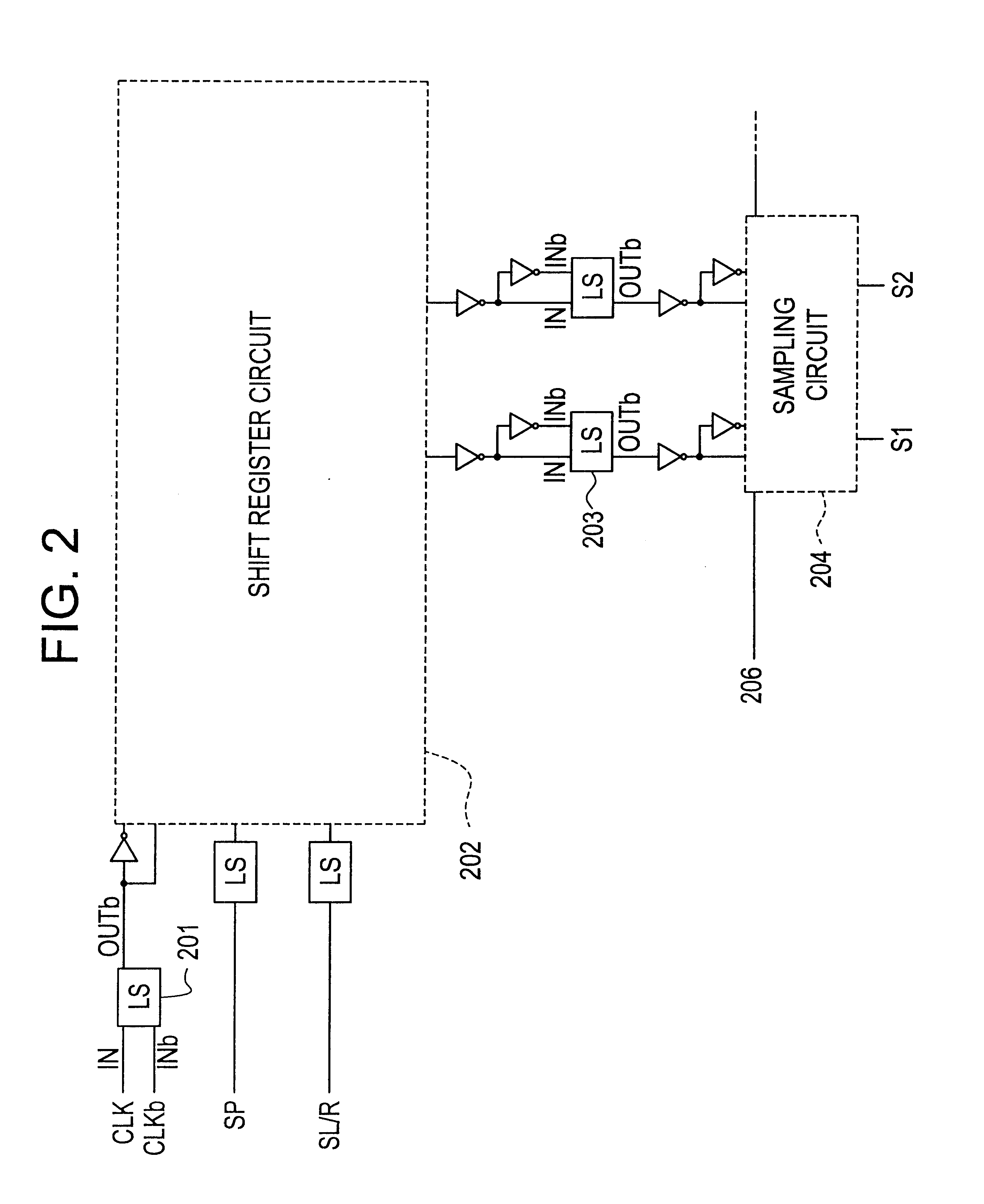Semiconductor display device and driving circuit therefor
a technology of display device and semiconductor, applied in semiconductor devices, instruments, electrical devices, etc., can solve problems such as easy damage of tft, unwanted radiation due to clock signals, and failure to operate type
- Summary
- Abstract
- Description
- Claims
- Application Information
AI Technical Summary
Benefits of technology
Problems solved by technology
Method used
Image
Examples
embodiment 1
The voltage amplitude level of the clock signal input to the first level shifter circuit is increased (made higher voltage) by the first level shifter circuit, from 2.5 V to 5 V in Embodiment 1, and the result is input to the shift register circuit.
The voltage amplitude level of the clock signal input to the shift register circuit is required to be a voltage amplitude level that is within the range in which the shift register circuit can operate. The shift register circuit can operate at 5 V in Embodiment 1. For example, in order to operate the shift register circuit of the source signal line side driving circuit at 12.5 MHz or greater in Embodiment 1, when configured by a TFT with a 2 .mu.m channel length, it is necessary for the voltage amplitude level of the clock signal input to the shift register circuit to be 4 V or greater. The voltage amplitude level is increased to 5 V in Embodiment 1, but the voltage amplitude level is not limited to this number for the present invention. ...
embodiment 2
Another example of a source signal line side driving circuit using the structure of the present invention, in which, by arranging level shifter circuits before and after a shift register circuit, the voltage amplitude level of a signal is increased in two stages, before and after the shift register circuit, is shown in Embodiment 2.
Next, a block diagram of the source signal line side driving circuit of Embodiment 2 is shown in FIG. 7. In Embodiment 2 a liquid crystal with a saturation voltage of 6 V is used. A clock signal CLK, with a voltage amplitude level of 3 V and from external to the is source signal line side driving circuit, is input to a first level shifter circuit of the source signal line side driving circuit. The voltage amplitude level of the clock signal input to the first level shifter circuit needs to be as low as possible, within the range in which the first level shifter circuit can operate, in order to suppress unwanted radiation to an extent where it does not bec...
embodiment 3
Another example of a source signal line side driving circuit using the structure of the present invention, in which, by arranging level shifter circuits before and after a shift register circuit, the voltage amplitude level of a signal is increased in two stages, before and after the shift register circuit, is shown in Embodiment 3.
Next, a block diagram of the source signal line side driving circuit of Embodiment 3 is shown in FIG. 8. In Embodiment 3 a liquid crystal with a saturation voltage of 7 V is used. A clock signal CLK, with a voltage amplitude level of 5 V and from external to the source signal line side driving circuit, is input to a first level shifter circuit of the source signal line side driving circuit. The voltage amplitude level of the clock signal input to the first level shifter circuit needs to be as low as possible, within the range in which the first level shifter circuit can operate, in order to suppress unwanted radiation to an extent where it does not become...
PUM
 Login to View More
Login to View More Abstract
Description
Claims
Application Information
 Login to View More
Login to View More - R&D
- Intellectual Property
- Life Sciences
- Materials
- Tech Scout
- Unparalleled Data Quality
- Higher Quality Content
- 60% Fewer Hallucinations
Browse by: Latest US Patents, China's latest patents, Technical Efficacy Thesaurus, Application Domain, Technology Topic, Popular Technical Reports.
© 2025 PatSnap. All rights reserved.Legal|Privacy policy|Modern Slavery Act Transparency Statement|Sitemap|About US| Contact US: help@patsnap.com



